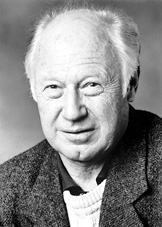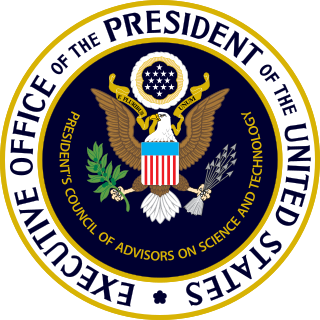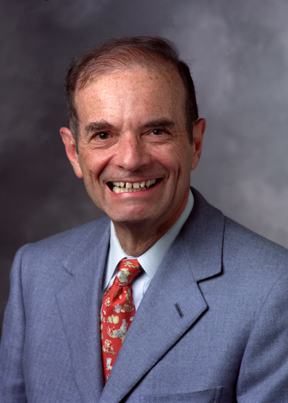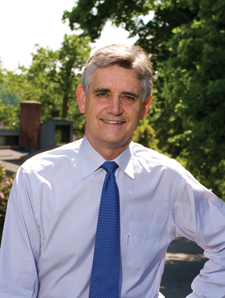Related Research Articles

Michael Smith was a British-born Canadian biochemist and businessman. He shared the 1993 Nobel Prize in Chemistry with Kary Mullis for his work in developing site-directed mutagenesis. Following a PhD in 1956 from the University of Manchester, he undertook postdoctoral research with Har Gobind Khorana at the British Columbia Research Council in Vancouver, British Columbia, Canada. Subsequently, Smith worked at the Fisheries Research Board of Canada Laboratory in Vancouver before being appointed a professor of biochemistry in the UBC Faculty of Medicine in 1966. Smith's career included roles as the founding director of the UBC Biotechnology Laboratory and the founding scientific leader of the Protein Engineering Network of Centres of Excellence (PENCE). In 1996 he was named Peter Wall Distinguished Professor of Biotechnology. Subsequently, he became the founding director of the Genome Sequencing Centre at the BC Cancer Research Centre.

Bruce Michael Alberts is an American biochemist and the Emeritus Chancellor’s Leadership Chair in Biochemistry and Biophysics for Science and Education at the University of California, San Francisco. He has done important work studying the protein complexes which enable chromosome replication when living cells divide. He is known as an original author of the "canonical, influential, and best-selling scientific textbook" Molecular Biology of the Cell, as an Editor-in-Chief of Science magazine. He was awarded the National Medal of Science for "intellectual leadership and experimental innovation in the field of DNA replication, and for unparalleled dedication to improving science education and promoting science-based public policy" in 2014.

Sir James Fraser Stoddart is a British-American chemist who is Chair Professor in Chemistry at the University of Hong Kong. He has also been Board of Trustees Professor of Chemistry and head of the Stoddart Mechanostereochemistry Group in the Department of Chemistry at Northwestern University in the United States. He works in the area of supramolecular chemistry and nanotechnology. Stoddart has developed highly efficient syntheses of mechanically-interlocked molecular architectures such as molecular Borromean rings, catenanes and rotaxanes utilising molecular recognition and molecular self-assembly processes. He has demonstrated that these topologies can be employed as molecular switches. His group has even applied these structures in the fabrication of nanoelectronic devices and nanoelectromechanical systems (NEMS). His efforts have been recognized by numerous awards, including the 2007 King Faisal International Prize in Science. He shared the Nobel Prize in Chemistry together with Ben Feringa and Jean-Pierre Sauvage in 2016 for the design and synthesis of molecular machines.

The President's Council of Advisors on Science and Technology (PCAST) is a council, chartered in each administration with a broad mandate to advise the president of the United States on science and technology. The current PCAST was established by Executive Order 13226 on September 30, 2001, by George W. Bush, was re-chartered by Barack Obama's April 21, 2010, Executive Order 13539, by Donald Trump's October 22, 2019, Executive Order 13895, and by Joe Biden's February 1, 2021, Executive Order 14007.

Lubert Stryer was an American academic who was the Emeritus Mrs. George A. Winzer Professor of Cell Biology, at Stanford University School of Medicine. His research over more than four decades had been centered on the interplay of light and life. In 2007 he received the National Medal of Science from President Bush at a ceremony at the White House for elucidating the biochemical basis of signal amplification in vision, pioneering the development of high density microarrays for genetic analysis, and authoring the standard undergraduate biochemistry textbook, Biochemistry. It is now in its tenth edition and also edited by Jeremy Berg, Justin Hines, John L. Tymoczko and Gregory J. Gatto, Jr.

David S. Eisenberg is an American biochemist and biophysicist best known for his contributions to structural biology and computational molecular biology. He has been a professor at the University of California, Los Angeles since the early 1970s and was director of the UCLA-DOE Institute for Genomics & Proteomics, as well as a member of the California NanoSystems Institute (CNSI) at UCLA.

John Kuriyan is the dean of basic sciences and a professor of biochemistry at Vanderbilt University School of Medicine. He was formerly the Chancellor's Professor at the University of California, Berkeley in the departments of molecular and cell biology (MCB) and chemistry, a faculty scientist in Berkeley Lab's physical biosciences division, and a Howard Hughes Medical Institute investigator. He is a member of the National Academy of Sciences and he has also been on the Life Sciences jury for the Infosys Prize in 2009, 2019 and 2020.
Dame Jean Olwen Thomas, is a Welsh biochemist, former Master of St Catharine's College, Cambridge, and Chancellor of Swansea University.

Peter B. Dervan is the Bren Professor of Chemistry at the California Institute of Technology. The primary focus of his research is the development and study of small organic molecules that can sequence-specifically recognize DNA, a field in which he is an internationally recognized authority. The most important of these small molecules are pyrrole–imidazole polyamides. Dervan is credited with influencing "the course of research in organic chemistry through his studies at the interface of chemistry and biology" as a result of his work on "the chemical principles involved in sequence-specific recognition of double helical DNA". He is the recipient of many awards, including the National Medal of Science (2006).
Steven G. Clarke, an American biochemist, is a director of the UCLA Molecular Biology Institute, a professor of chemistry and biochemistry at UCLA biochemistry department. Clarke heads a laboratory at UCLA's department of chemistry and biochemistry. Clarke is famous for his work on molecular damage and discoveries of novel molecular repair mechanisms.

Bruce William Stillman is a biochemist and cancer researcher who has served as the Director of Cold Spring Harbor Laboratory (CSHL) since 1994 and President since 2003. He also served as the Director of its NCI-designated Cancer Center for 25 years from 1992 to 2016. During his leadership, CSHL has been ranked as the No. 1 institution in molecular biology and genetics research by Thomson Reuters. Stillman's research focuses on how chromosomes are duplicated in human cells and in yeast Saccharomyces cerevisiae; the mechanisms that ensure accurate inheritance of genetic material from one generation to the next; and how missteps in this process lead to cancer. For his accomplishments, Stillman has received numerous awards, including the Alfred P. Sloan, Jr. Prize in 2004 and the 2010 Louisa Gross Horwitz Prize, both of which he shared with Thomas J. Kelly of Memorial Sloan-Kettering Cancer Center, as well as the 2019 Canada Gairdner International Award for biomedical research, which he shared with John Diffley.

Donald Crothers was a professor of chemistry at Yale University in the United States. He was best known for his work on nucleic acid structure and function.
Virander Singh Chauhan is an Indian scientist and a Rhodes Scholar working in the fields of genetic engineering and biotechnology. He is known for his contributions to the development of a recombinant vaccine for malaria. and for synthetic structural peptides with biological functions. He was honored by the Government of India in 2012 with the fourth highest Indian civilian award of Padma Shri. He is the present Chancellor of the Gandhi Institute of Technology and Management.
Juli Feigon is a Distinguished Professor of Biochemistry at the University of California, Los Angeles, where she has been a faculty member since 1985. She was elected to the United States National Academy of Sciences in 2009. Her research focuses on structural studies of nucleic acids by nuclear magnetic resonance spectroscopy along with other biophysical techniques.
Merton Franklin Utter was an American microbiologist and biochemist.
Shantanu Chowdhury is an Indian structural biologist and a professor at Institute of Genomics and Integrative Biology of the Council of Scientific and Industrial Research. He is known for developing a mechanism for gene regulation mediated by DNA Secondary-Structure in diverse cellular contexts. An elected fellow of the National Academy of Sciences, India, he is a recipient of the National Bioscience Award for Career Development of the Department of Biotechnology in 2010. The Council of Scientific and Industrial Research, the apex agency of the Government of India for scientific research, awarded him the Shanti Swarup Bhatnagar Prize for Science and Technology, one of the highest Indian science awards, in 2012, for his contributions to biological sciences.

William Michael Gelbart is Distinguished Professor of Chemistry and Biochemistry at the University of California, Los Angeles, and a member of the California NanoSystems Institute and the UCLA Molecular Biology Institute. He obtained his Bachelor of Science degree from Harvard University in 1967, his Master's (1968) and PhD (1970) degrees from the University of Chicago, and did postdoctoral work at the University of Paris (1971) and the University of California, Berkeley (1972). After 30 years of research in theoretical physical chemistry, contributing notably to the fields of gas-phase photophysics, optical properties of simple liquids, and the statistical physics of complex fluids, he started a biophysics laboratory with Charles Knobler in 2002 to investigate the physical aspects of viral infectivity.

Robin L. Garrell is an American chemist, academic and former president of The Graduate Center, CUNY. Until 2020, Garrell served as vice provost for graduate education and dean of graduate division at University of California, Los Angeles (UCLA). Prior to this role, Garrell was assistant professor at the University of Pittsburgh from 1984 to 1991, then joined the faculty in the department of chemistry and biochemistry at UCLA, where she became full professor and held a joint appointment in bioengineering. Garrell assumed her current position at The Graduate Center on August 1, 2020. </ref> On August 28, 2023 she announced that she would be stepping down as president of the CUNY Graduate Center effective September 29, 2023.
Loren Dean Williams is a biophysicist, biochemist, astrobiologist, and professor in the School of Chemistry and Biochemistry at the Georgia Institute of Technology in Atlanta, Georgia. His research seeks to understand the structural basis for macromolecular reactions, from the role of nucleic acids as targets of chemotherapeutics to the ancestral biochemistry of the ribosome during the origin of life.
References
- ↑ "UCLA Department of Chemistry and Biochemistry : UCLA Portal". Faculty.chemistry.ucla.edu. Retrieved 2011-10-28.
- ↑ "Advisory Council". ncse.com. National Center for Science Education. Archived from the original on 2013-08-10. Retrieved 2018-10-30.
- ↑ Dickerson, Richard E., UCLA Chemistry & Biochemistry